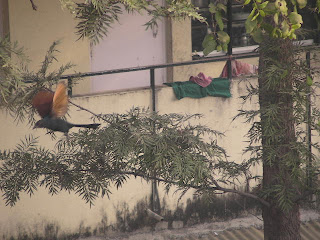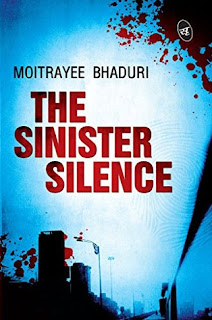Some more Birding..
Only these 2 can give me precise info about the birds I’ve recently spotted through my camera lens, Dr. Ajay Pradhan & Wikipedia. And this is what I’ve learnt the second time around…
The Greater Coucal or the Crow Pheasant (Centropus sinensis) is a non-parasitic member of the cuckoo order, the Cuculiformes. It is a widespread resident in India
The Coucal or the Crow Pheasant is colloquially referred to as the Bharadwaj bird or Kumbhar kaola in Marathi. There are mainly too varieties- The Greater & the Lesser, informs Dr. Ajay and what I’ve clicked here is the Greater Coucal. It is considered lucky to have spotted one!
With a purplish black body and rust coloured wings it is a large bird at 48 cm. The play of sunlight on its wings when in flight makes it appear golden! An extremely handsome bird it is.
This pair is the Eurasian Golden Oriole (Oriolus Oriolus). As the name clearly suggests, these birds are found in Europe and Asia except for the northern regions. Mostly flying in pairs, the female of the couple (seen to your left) is recognized by the greenish-yellow coloration on the chest. The male has black coloration under the wings, between the eyes and on the yellow bill.
These migratory birds return to Eurasia by March.
The call is a screech like a jay, but the song is a beautiful fluting weela-wee-ooo or or-iii-ole, unmistakable once heard.
The Small Minivet, Pericrocotus cinnamomeus is found in tropical southern Asia . The Small Minivet is 16 cm long with a strong dark beak and long wings. The Small Minivet feeds on insects, forms small flocks and its call is a high, thin swee swee swee.
Quite a handsome bird this little male is with its chest fading from a bright red down to yellow and white.







Comments
Or why dont you invite me for a coffee instead ? ;-)
Yes, have already given my application for an SLR with my hubby's accounts deptmt. LOL
The next season you may find better pix rolled out..Till then plz make do with these!
:(
... As for the pics, Try cropping your pics to a small size by picasa or some other software ... so that you can zoom into the birds...
Well, coming to real ornithology concerning this post, man, that was so much info. Loved the pics, esp. the small minivet. :-)
glad you like the post..
I cant comment on ur birding talents!
:P
Yes Ornithology is very interesting otherwise!
the minivet, did you see it alone? whenever i have seen them (rare), i have seen them in bunches.
Yes, I spotted a lone minivet and havent spotted it again...:(
Can you guide me what cam I should pick up for such photography? Any special zoom lens and filter to suggest?
Im planning to invest in a good cam seriously!
Am so happy to see you are enjoying my newly found passion too..
Yes, some birds may be common but they are so restless and flitting always that its very difficult to capture one good pic' without a good SLR..
I try!!
:D
Thanks a ton for all the complements..:)
The Golden Oriole is beautiful, but hopefully you will get to see a Blacknaped Oriole some day. The golden fellow pales in comparison!